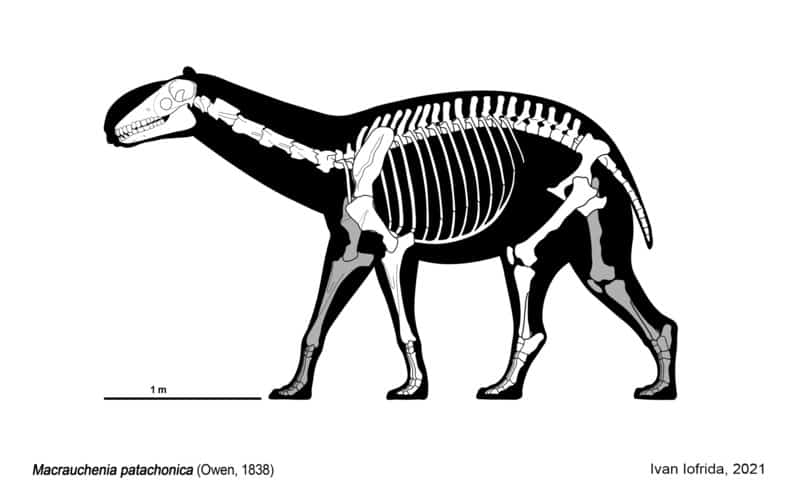The Macrauchenia is an extinct herbivore belonging to a class of animals known as litopterns. They were large, land-bound animals originally found in South America. Charles Darwin found the first fossils of this genus during his famous journey on the Beagle. Several other Maracuchenia fossils were found in other countries, such as Argentina, Chile, and Brazil.
Scientific Name
The scientific name for Macrauchenia is Macrauchenia. Macrauchenia was a plant-eating mammal, that was alive up until 20,000 to 10,000 years ago. It belongs to the genus of “Macraucheniidae” or “robust litopterns.” The name “Macrauchenia” literally means long llama. The word can be broken down into “macros” and “auchen.”
In Greek, macros means long, while auchen means neck.
- Kingdom: Animalia
- Phylum: Chordata
- Class: Mammalia
- Order: Litopterna
- Family: Macraucheniidae
- Genus: Macrauchenia
Description and Size
The Macrauchenia had a camel-like body, legs with a muscular build, and a relatively small head and skull. Macrauchenia also had only three toes. Their unique feature was that their nasal opening was high on their skull, with a tapir-like trunk. Since the animal was herbivorous, it had a mouth full of 44 teeth. However, these teeth were not very sharp. Their overall build was said to resemble that of a rhinoceros, just with a camel-like neck on the top.
Some of its defining features are:
| Height | 5-7 feet |
| Body Weight | 1500-2500 lbs. |
| Length | 10-12 feet |
Diet: What Did the Macrauchenia Eat?
The Macrauchenia was a herbivorous creature. Its long neck was an adaptation to grab leaves from tree tops. However, this does not indicate that they were restricted to forests alone. A few of their fossils have been found in grazing fields in Chile. Therefore, they generally fed on plants from high trees and lived in plant-oriented environments, much like giraffes.
The Macrauchenia lived long ago in the stone age, so the answer to this question is based on an analysis of fossils and data about their habitat.
Habitat: When and Where it Lived
Macrauchenia went extinct reasonably recently. Fossils suggest they were alive until up to 10,000 years ago during the paleolithic era. They lived in huge herds found in South America. Most of their fossils have been found in modern-day Chile, Peru, Brazil, Argentina, Ecuador, and Bolivia.
Male Macrauchenia usually lived separately from the rest of the herd. The herds thrived in forests or large grassy fields. These animals were land creatures and did not spend much time in the water except for when bathing or drinking.

©Ivan Iofrida / Creative Commons Attribution-Share Alike 4.0 International license – License
Threats and Predators
Since the Macrauchenia was a herbivorous animal, most carnivorous creatures living at their time were predators of it. They often dealt with predators by outrunning them with their long legs or kicking them if needed. Their body was well-adapted to run fast and escape predators. Nevertheless, they did become prey to ambush hunters such as the Thylacosmilus, Smilodon, and the S. populator (which were carnivores of the Stone Age).
Discoveries and Fossils: Where it was Found
Charles Darwin discovered the first Macrauchenia fossils in 1838 while on a quest in Puerto San Julian. These bones were later analyzed by anatomist, Richard Owen. The animal was originally thought to be a prehistoric llama and was later given the name Macrauchenia patachonica. The largest samples of the Macrauchenia fossil were found in Argentina and Chile.
Other regions where these fossils were found include Bolivia, Brazil, Paraguay, Venezuela, Peru, and Ecuador. Overall, the animal was very widespread across South America.
Extinction: When Did it Die Out?
Based on the fossils discovered of these species, we know that Macrauchenia resided in what is modern-day South America. They existed there until about 11,000 years ago, which was roughly the end of the Pleistocene epoch. The Pleistocene epoch was the last Ice Age, which began around 2.5 million years ago and ended 11,700 years ago.
At the end of the Pleistocene epoch, many animals and species, including Macrauchenia, became extinct. The last Ice Age was not an extinction event, but due to climate change and human influence, many animals, including the Macrauchenia, eventually died out.
Similar Animals to the Macrauchenia
Macrauchenia had many similarities with our modern-day animals. Some of these include:
- Llamas and Camels: Macrauchenia’s anatomy was very similar to animals belonging to the camel family, such as llamas. In fact, their neck vertebrae have an anatomical detail that can only be found in the camel family.
- Elephant: Unlike most other animals, a Macrauchenia’s long nose was right between its eyes, looking very similar to an elephant’s trunk.
- Horses and Rhinos: The build and weight ranged between those of horses and rhinos.
Based on their genealogy, the Macrauchenia is actually considered distant relatives of tapirs, horses, and rhinos. Altogether, these animals belong to a group called Perissodactyla.
The photo featured at the top of this post is © Olllga / Creative Commons Attribution 3.0 Unported license – License / Original
Sources
- Dino Fandom Wiki, Available here: https://dino.fandom.com/wiki/Macrauchenia#:~:text=Macrauchenia%20was%20a%20member%20of,and%20competition%20from%20new%20prey.
- Walking With Fandom Wiki, Available here: https://walkingwith.fandom.com/wiki/Macrauchenia
Thank you for reading! Have some feedback for us? Contact the AZ Animals editorial team.






